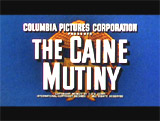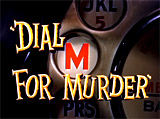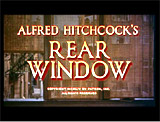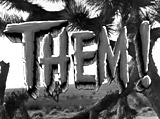
|
![]()
Greatest Films of the 1950s
1950 | 1951 | 1952 | 1953 | 1954 | 1955 | 1956 | 1957 | 1958 | 1959
Title Screen Film Genre(s), Title, Year, (Country), Length, Director, Description 


Animal Farm (1954, UK), 72 minutes, D: Joy Batchelor, John Halas


The Barefoot Contessa (1954, US/It.), 128 minutes, D: Joseph L. Mankiewicz



The Caine Mutiny (1954), 125 minutes, D: Edward Dmytryk
Young Princeton graduate ensign Willie Keith (Robert Francis) told how he was assigned to a dilapidated and rusty minesweeper named the Caine, sternly captained by Lt. Commander Philip Queeg (Humphrey Bogart). The eccentric Queeg reprimanded the crew for messy shirttails, haircuts, and other petty things, and soon it was apparent he might be paranoid and mentally unbalanced (evidenced by his rolling silver metal balls in his hand). The captain began to demonstrate how incompetent he was, during a beach-landing incident in which he was dubbed "Old Yellowstain." The question arose: Could the naval officers take control of the ship, without being accused of mutiny? The last straw was Queeg's mis-treatment of an incident involving leftover strawberries in the officer's mess, and when Queen mismanaged the ship during a typhoon and executive officer Lt. Steve Maryk (Van Johnson) stepped in and took charge. Maryk and Keith were court-martialed for mutiny, to be defended by Barney Greenwald (Jose Ferrer). Lt. Tom Keefer (Fred MacMurray), the true instigator of the mutiny idea, testified that taking the ship from Queeg was in error, to save himself. The prosecution's case faltered when Queeg was cross-examined, and he became frantic, paranoid, and blamed everyone for the Caine's problems, while nervously rolling the clanking steel balls in his hand. The two officers were acquitted.


Carmen Jones (1954), 105 minutes, D: Otto Preminger



Chikamatsu Monogatari (1954, Jp.) (aka The Crucified Lovers, or A Story From Chikamatsu), 102 minutes, D: Kenji Mizoguchi


Creature from the Black Lagoon (1954), 79 minutes, D: Jack Arnold
This classic Universal horror film was by director Jack Arnold - originally shot in 3-D, and the last great prototypical classic from Universal Studios. The campy film told about an anthropological expedition led by Dr. Carl Maia (Antonio Moreno) and funded by Dr. Mark Williams (Richard Denning) to a Brazilian river in the Amazon, conducted by Dr. Maia, Dr. Williams, ichthyologist Dr. David Reed (Richard Carlson) and his dark-haired girlfriend/fiancee Kay Lawrence (Julia Adams), and scientist Dr. Edwin Thompson (Whit Bissell). There was fossilized and other gruesome evidence of an unusual, prehistoric, amphibious web-handed and footed humanoid-reptile. It was eventually discovered that the Gill-Man (Ben Chapman) was living in dark lagoon known as the "Black Lagoon" - in scary and superbly-photographed underwater sequences, the creature expressed 'Beauty-and-the-Beast' love interest in bathing beauty Kay, stalking and watching her from below as she swam above him in a white one-piece suit. After some deadly encounters with the Gill-Man when captured, it then kidnapped Kay from the boat, dove into the water and took her back to its swampy cave, but she was soon rescued - while the creature was shot, badly injured and sank into the deep lagoon.

Dial M for Murder (1954), 105 minutes, D: Alfred Hitchcock
This was Hitchcock's screen version of English playwright Frederick Knott's successful stage play. It was filmed in 3-D with the technology that was available at the time, and judged as one of the greatest 3D films ever made. [Note: It was remade as A Perfect Murder (1998).] Hitchcock's thriller masterpiece told about a charming, sophisticated yet villainous husband - an ex-tennis pro named Tony Wendice (Ray Milland), who masterminded the murder of his unfaithful wealthy socialite wife Margot Wendice (Grace Kelly) for having an affair with American crime-mystery writer Mark Halliday (Robert Cummings), so that he could inherit her fortune. Wendice blackmailed or "influenced" C.A. Swann/Captain Lesgate (Anthony Dawson), a former classmate with a petty-criminal record, to commit her "perfect murder" for £1,000 pounds cash. During the attempted strangulation scene, the tension was ratcheted up. Tony's plan was to have his wife leave her bedroom to answer the living room phone, to enable Swann to strangle her from behind the drawn window curtains where he was hiding. In one of the most suspenseful scenes, Tony dialed his home number (dialing M for murder) from a hotel lobby's payphone, but because his watch had unexpectedly stopped, he was about eight minutes too late. Tension was intensified and his plan was botched because he was planning to call at 11:00 pm, but the call was about 11:08 pm. The assassin was frazzled and about to leave because of the delay. When the phone finally rang, the camera slowly panned to the left around Margot as she came into the living room and answered. The camera moved to view Swann's position behind the living room curtains. He approached with a twisted scarf and wrapped it around her neck, but she foiled his strong attack by fighting back. She reached behind her - searching for a weapon (a pair of scissors) to defend herself and then killed the assassin by stabbing him in the back. Tony's new plan to outwit the police seemed to succeed - making it appear that Margot had an ulterior motive for killing Swann (he was blackmailing her), and she was rapidly brought to trial and convicted. However, there were anomalies in Tony's story that didn't add up, and wily Inspector Hubbard (John Williams) was on the case. In the concluding scene, the guilty Tony opened the door with the crucial duplicate latchkey (using Margot's front-door key that he had stolen from her handbag, and then planted for Swann's use) that Swann had retrieved from under the carpet on the 5th step of the stairs outside the apartment. Earlier, no key had been found on the dead assassin Swann (and there was no forced entry either, because he didn't have mud on his shoes) - Swann had entered using the planted key and immediately replaced it under the stairs' rug. When Tony entered (using the key under the carpet stairs) and turned, he realized that he had been found out: (The Inspector predicted Tony's downfall: "Once he opens that door, we shall know everything").

Gojira (1954, Jp.) (aka Godzilla), 96 minutes, D: Ishirô Honda
The influential classic Japanese horror film, with effective special effects, was later released in 1956 as a shortened, re-edited Americanized version (with Raymond Burr as US reporter Steve Martin). The film served as an allegory for the Hiroshima and Nagasaki attacks almost 10 years earlier. In the original, Godzilla was a dormant (but come-to-life) giant, fire-breathing, dinosaur-like, reptilian monster/creature. It had been awakened, irradiated and mutated by atomic H-Bomb tests in the ocean, revealed when ocean waters turned boiling hot. The radioactive Godzilla went on a destructive, terrorizing rampage, and destroyed a Japanese freighter. The superstitious villager-inhabitants of Odo Island thought the ancient legend of the creature had come true. The beast further rampaged through mid-50s Tokyo Bay and then the city of Shinagawa. The film's sub-text was about a devastating, dangerous weapon developed by Dr. Daisuke Serizawa (Akihiko Hirata) known as an "Oxygen Destroyer" - a WMD that could destroy Godzilla. The scientist reluctantly allowed the device to be used against the kaiju, but only after destroying his research documents and materials. He then deliberately sacrificed himself (to save humanity from further destruction if the horrible weapon's plans were revealed) when he detonated his device underwater and cut his own diving suit air-cord, killing both Godzilla and himself.


Human Desire (1954) (aka The Human Beast), 91 minutes, D: Fritz Lang
Fritz Lang's grim, noirish tale of fate, infidelity, blackmail and obsessive passion was based on Emile Zola's 1890 novel La Bete Humaine. This remake was already filmed twice before: the silent film Die Bestie im Menschen (1920, Germ.) and Jean Renoir's French film La Bête Humaine (1938, Fr.) (aka The Human Beast). Vicki Buckley (Gloria Grahame) was the amoral, brassy, manipulative and sexually-frustrated wife of violence-prone, moody and depressed railway yard worker Carl (Broderick Crawford). The film's tagline described her: "She was born to be bad...to be kissed...to make trouble!" After her husband Carl was fired from his job, he had his wife Vicki intervened with powerful John Owens (Grandon Hughes), her mother's former boss, to restore his job. When brutish Carl suspected that she had slept with the man for favors, he stalked and then murdered Owens with a knife in a train compartment. Returning Korean War veteran and train engineer Jeff Warren (Glenn Ford) became inextricably involved the day of the murder while off-duty, when he witnessed that Vicki was present at the murder scene. During the trial though, he protectively avoided identifying Vicki as the passenger he saw near Owens' compartment. Soon, Vicki was confessing to Jeff how her abusive marriage was crumbling and they entered into a passionate adulterous affair. His libidinous desire for her (and Vicki's own murderous intentions) led him to nearly kill her violence-prone husband, because Carl was threatening blackmail (if she left him) with an incriminating letter that he made her write. In the film's conclusion after Carl was fired again, he accused Vicki of infidelity. In turn, she taunted him by admitting her affair with Jeff and that Owens had seduced her to acquire Carl's job. Insanely jealous, Carl then strangled Vicki to death.




Johnny Guitar (1954), 110 minutes, D: Nicholas Ray



Journey to Italy (1954, It.) (aka Viaggio in Italia), 97 or 85 minutes, D: Roberto Rossellini



On the Waterfront (1954), 108 minutes, D: Elia Kazan
A compelling, evocative, gritty, Best Picture-winning drama about union corruption and violence on the New York waterfront and the struggle of an ex-prize fighter against it. Inarticulate ex-boxer champ Terry Malloy (Marlon Brando) witnessed the murder of a fellow dock worker, a victim of gangster union boss Johnny Friendly's (Lee J. Cobb) oppressive hold over the longshoremen - punished for 'singing' to an investigation commission. When Terry began to fall in love with shy and frail Edie (Eva Marie Saint), the dead man's sister, his allegiances were challenged. Contained the famous Brando "I coulda been a contender" speech in the back seat of a taxi with his crooked, scheming lawyer brother Charlie (Rod Steiger). After his brother's murder, he defiantly stood up against the hoodlums on the waterfront.



Rear Window (1954), 113 minutes, D: Alfred Hitchcock
Hitchcock's voyeuristic masterpiece - a suspenseful, nail-biting thriller about a wheelchair-bound, immobilized photographer who believed he had witnessed a murder during his convalescence. During a hot New York summer, photo-journalist L. B. 'Jeff' Jeffries (James Stewart) recuperated in his apartment from a broken leg. He wiled away the time by observing - and spying on neighbors through his rear window (with binoculars and his telephoto camera), while being cared for by his fashionable girlfriend Lisa (Grace Kelly) and nurse-therapist Stella (Thelma Ritter). He experienced all of life's extremes - a honeymooning couple, dancer Miss Torso, spinsterish Miss Lonelyhearts, and the bickering, intriguing Thorwalds. Dissuaded by his police detective friend, Lisa, and Stella, he persisted with attentive observations and suspicions about Thorwald (Raymond Burr) killing his wife.


Sabrina (1954), 112 minutes, D: Billy Wilder

Salt of the Earth (1954), 94 minutes, D: Herbert J. Biberman

Sansho the Bailiff (1954, Jp.) (aka Sanshô Dayû), 124 minutes, D: Kenji Mizoguchi



Senso (1954, It.) (aka The Wanton Countess), 118 or 93 minutes, D: Luchino Visconti


Seven Brides for Seven Brothers (1954), 103 minutes, D: Stanley Donen



Seven Samurai (1954, Jp.) (aka Shichinin No Samurai), 207 minutes, D: Akira Kurosawa

Silver Lode (1954), 81 minutes, D: Allan Dwan



A Star is Born (1954), 176 minutes, D: George Cukor
A classic tearjerker, the first re-make of William Wellman's non-musical, classic 1937 film starring Janet Gaynor and Fredric March. It was inspired by What Price Hollywood? (1932) also directed by Cukor. The emotionally-intense psycho-drama also hinted at the real-life troubles and problems (five marriages) in the career of its female star - Judy Garland - a victim of the Hollywood studio system - during the film's making. It was Garland's comeback and self-referential film (after she had been dismissed from her lead role in Annie Get Your Gun (1950)), and then suffered from alcoholic binges and suicide attempts. Young aspiring newcomer-star Esther Blodgett's (Judy Garland) singing career was launched in Hollywood - as Vicki Lester, by a fading, alcoholic film star Norman Maine (James Mason) whose popularity was on the decline. Their marriage was tested by the tragic consequences of his personal self-destruction, disintegration and loss of fame, especially in the Academy Awards Banquet Ceremony scene when Norman accidentally slapped her. His stunning suicidal demise was inevitable (he committed suicide by walking into the ocean), but duly honored by his wife onstage at the Shrine Theatre when she proudly introduced herself as Mrs. Norman Maine. Included Garland's memorable songs: "The Man That Got Away" and the main production number "Born In a Trunk."


La Strada (1954, It.) (aka The Road), 94 minutes, D: Federico Fellini


Them! (1954), 94 minutes, D: Gordon Douglas
Noted as the first "Big Bug" Monster feature with great special effects and a convincing story - setting off a science-fiction trend. After atomic tests in 1945 in the White Sands area of the New Mexico desert near Alamogordo, a young Ellinson girl (Sandy Descher) was found wandering, in shock, by two state police troopers (led by Sgt. Ben Peterson (James Whitmore)) and brought to a police station. Her trailer camp (where she was staying with her parents and brother) had been attacked and destroyed, and they were missing. After FBI agent Robert Graham (James Arness) and two scientists (Dr. Harold Medford (Edmund Gwenn) and his daughter Dr. Pat Medford (Joan Weldon)) investigated strange pulsating sounds and formic acid in victims, it was determined that recent atomic testing had mutated a race of giant ants. The ants were traced to their nest and two queen Ants that had hatched and traveled into the storm drain sewers under Los Angeles to spread further destruction. The film ended with the statement: " When Man entered the Atomic Age, he opened a door into a new world. What we'll eventually find in that new world, nobody can predict."

Three Coins in the Fountain (1954), 102 minutes, D: Jean Negulesco